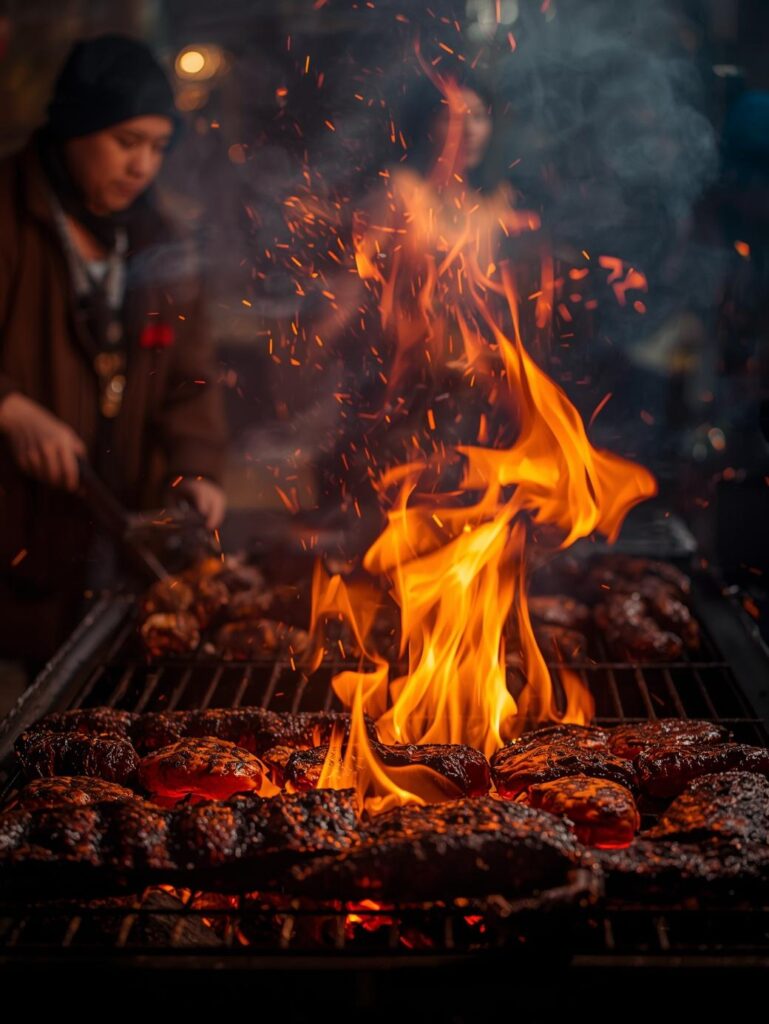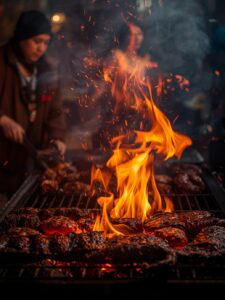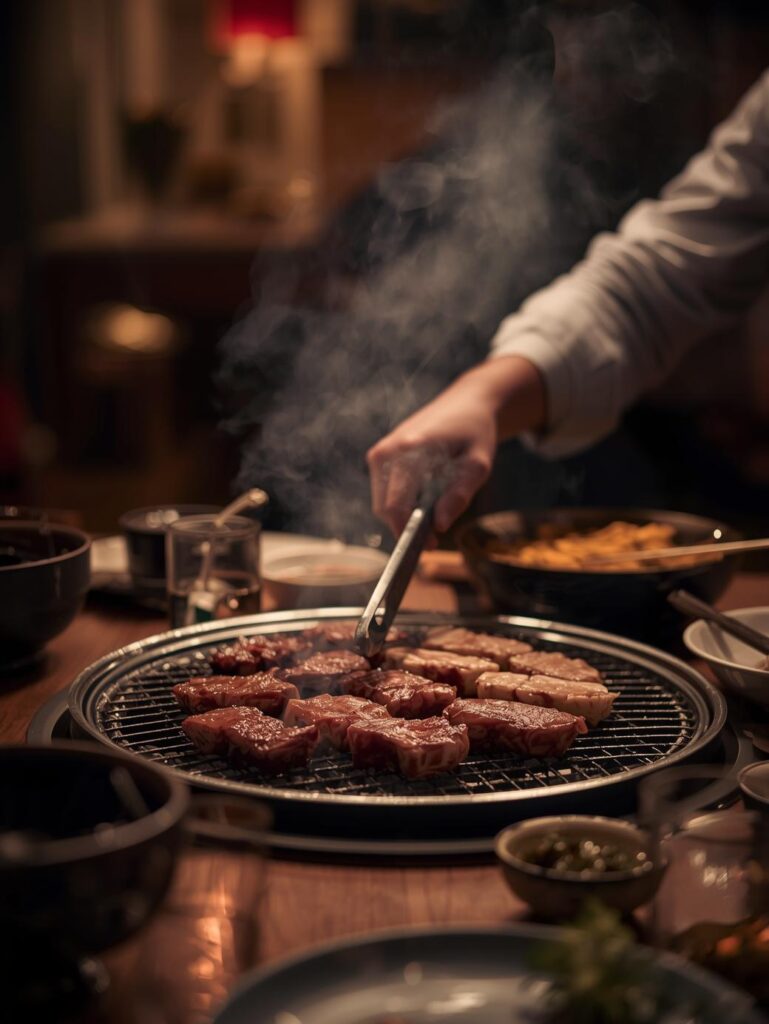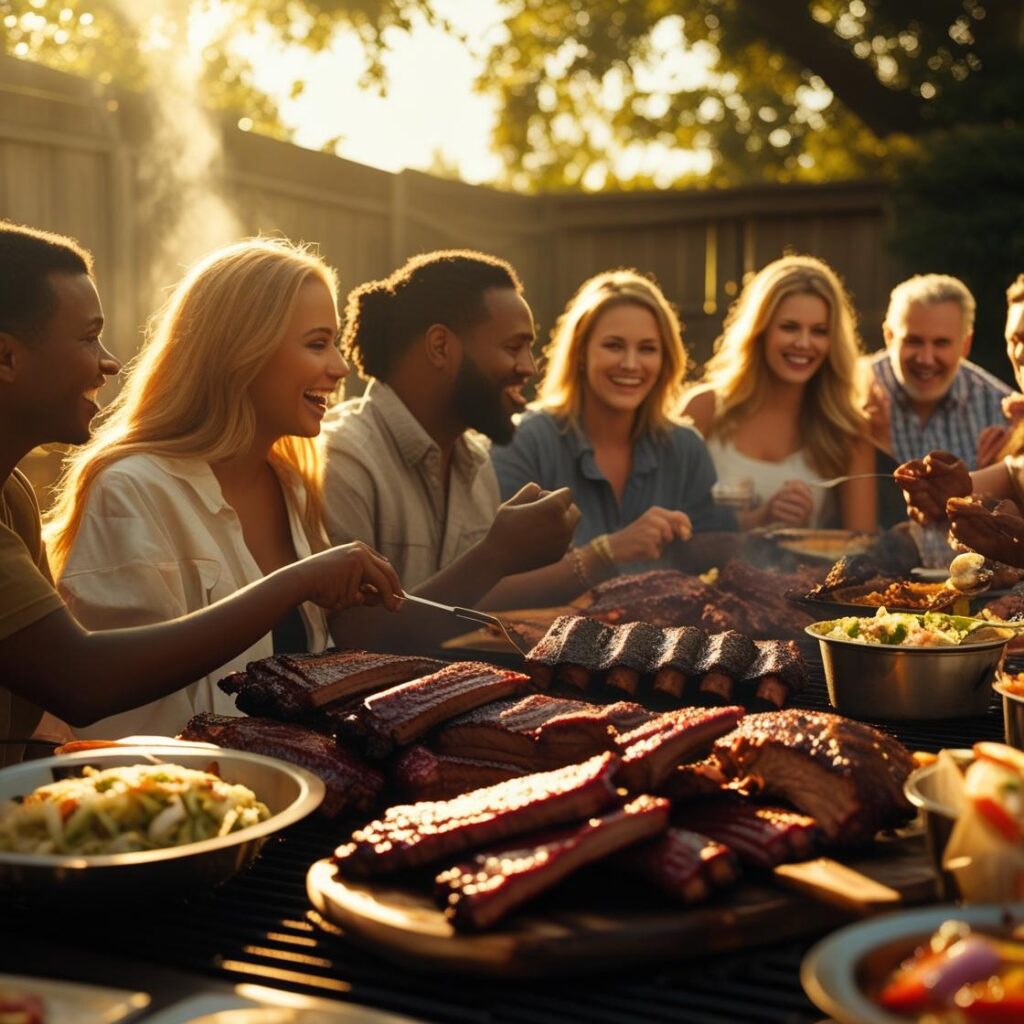Expert’s Note: This global BBQ guide expands upon our deep dives into American regional styles and Brazilian churrasco. BBQ is humanity’s universal language, but every culture has its own dialect. From the slow smoke of Texas to the quick fire of Japan, from the complex spices of Jamaica to the simple salt of Argentina—this is the world’s conversation with fire, captured on a plate.
International BBQ Styles: Your Global Guide to Fire, Smoke, and Flavor
“BBQ is the world’s original social network. Long before apps and algorithms, we gathered around fire to share stories, celebrate harvests, and honor traditions. Every culture that discovered fire eventually created its own BBQ—a unique expression of local ingredients, climate, and community. To explore international BBQ isn’t just to learn new recipes; it’s to travel through time and taste the soul of civilizations forged in flame.”
International BBQ Styles: Global Guide to Fire Traditions & Techniques
Download the International BBQ Passport - Styles, Cuts & Techniques at a Glance
Welcome to the world’s greatest BBQ journey—a culinary expedition that spans continents, cultures, and centuries of fire mastery. While American BBQ rightfully claims its throne in the smoke pantheon, it’s just one chapter in a global epic of live-fire cooking. This guide will transport you from the pampas of Argentina to the yakitori stalls of Tokyo, from the braai stands of South Africa to the jerk pits of Jamaica. Prepare to expand your definition of BBQ and discover techniques that will transform your approach to fire forever.
🎯 THE GLOBAL BBQ PHILOSOPHY: FIRE AS CULTURAL EXPRESSION
Understanding the different relationships cultures have with fire reveals why BBQ varies so dramatically worldwide.
⚙️ The Three Global BBQ Archetypes
How Cultures Approach Fire and Meat
- Low & Slow Smoke Culture (Americas): The art of transformation. Using smoke and time to make tough cuts tender. Focus on large cuts, complex rubs, and smoke penetration. This includes American styles, Mexican barbacoa, and Canadian smoked meats.
- High Heat Live-Fire Culture (Latin America/South Africa): The celebration of quality ingredients. Quick cooking over intense heat that honors premium cuts. Minimal seasoning lets the meat shine. Examples: Argentine asado, Brazilian churrasco, South African braai.
- Marinade & Sauce-Focused Culture (Asia/Caribbean): The flavor infusion philosophy. Complex marinades, glazes, and sauces that penetrate before quick cooking. Often uses smaller cuts and skewers. Includes Korean BBQ, Japanese yakitori, Jamaican jerk.
- Hybrid Approaches: Many cultures blend these approaches. Philippine lechon uses both slow roasting and complex marinades. Turkish kebabs combine marination with live-fire cooking.
🎯 Global BBQ vs. American BBQ: The Fundamental Differences
🇺🇸 American BBQ Tradition
- Low & slow (6-18 hours)
- Tough cuts transformed
- Smoke-forward flavor
- Dry rubs & thick sauces
- Wood-specific smoke flavors
- Pork & beef focused
🌍 Global BBQ Traditions
- Variable times (30 sec – 6 hours)
- Celebrates premium cuts
- Marinade & fire-forward
- Complex spice pastes & sauces
- Direct heat & ember cooking
- Diverse proteins
🔥 LATIN AMERICAN FIRE TRADITIONS
Where meat meets fire in its purest, most celebratory forms.
🇦🇷 Argentine Asado: The Sacred Social Fire
The Gaucho’s Gift to the World
- Philosophy: Asado isn’t a cooking method—it’s a social event that can last 4-6 hours. The fire (fuego) is the centerpiece, and the asador (grill master) is the conductor. It’s about community, conversation, and shared experience.
- Technique: Cooking over wood embers (not charcoal) on a parrilla (grill) or cross-style asador. The heat is controlled by raising/lowering the grill or moving embers. Slow cooking with intense radiant heat.
- Signature Dishes: Entraña (skirt steak), costillas (ribs), chorizo, morcilla (blood sausage), provoleta (grilled provolone). Everything seasoned with only coarse salt.
- Secret Weapon: Chimichurri—the vibrant sauce of parsley, oregano, garlic, oil, and vinegar that accompanies every bite.
- Home Adaptation: Use a charcoal grill with wood chunks. Cook larger cuts slowly. Make authentic chimichurri sauce. Focus on the social experience.
🇧🇷 Brazilian Churrasco: The Meat Carnival
The Rodízio Revolution
- Philosophy: Abundance and celebration. Continuous service of different meats until you surrender. The churrasqueiro (grill master) is a performing artist.
- Technique: Large cuts skewered and cooked over high heat. The iconic picanha (sirloin cap) is the star—thick fat cap rendering over flames. Constant rotation creates perfect crust and juicy interior.
- Signature Dishes: Picanha, fraldinha (bottom sirloin), coração de frango (chicken hearts), costela (beef ribs).
- Secret Weapon: Farofa (toasted manioc flour) and vinagrete (Brazilian salsa) as accompaniments.
- Home Adaptation: Use sword skewers or regular skewers. Master the churrasco technique with a two-zone fire. Season with coarse salt only.
📊 The Americas BBQ Matrix
🎯 North, Central & South American BBQ Styles Compared
| Style | Origin | Signature Dish | Cooking Method | Key Flavor |
|---|---|---|---|---|
| Texas BBQ | USA | Beef Brisket | Low & Slow Smoke | Oak Smoke, Salt & Pepper |
| Barbacoa | Mexico | Beef Cheek | Pit Steam-Roasting | Chiles, Bay Leaves |
| Asado | Argentina | Entraña Skirt Steak | Wood Ember Grilling | Coarse Salt, Chimichurri |
| Churrasco | Brazil | Picanha | High Heat Rotisserie | Coarse Salt, Garlic |
| Jerk | Jamaica | Jerk Chicken/Pork | Pimento Wood Smoking | Allspice, Scotch Bonnet |
🌏 ASIAN BBQ TRADITIONS
Where precision, marinades, and high heat create explosive flavors.
🇰🇷 Korean BBQ: The Interactive Tabletop Experience
The Social Grill at Your Table
- Philosophy: Communal dining where everyone becomes their own grill master. The experience is as important as the food—sizzling, sharing, and wrapping together.
- Technique: Thinly sliced meats cooked quickly on tabletop grills. Bulgogi (marinated beef) and galbi (short ribs) are marinated for hours in sweet-soy or spicy sauces.
- Signature Dishes: Bulgogi, galbi, samgyeopsal (pork belly), dwaeji bulgogi (spicy pork).
- Secret Weapon: Ssam—wrapping grilled meat in lettuce with rice, garlic, ssamjang (wrapping sauce), and kimchi.
- Home Adaptation: Use a tabletop grill or cast iron skillet. Master the bulgogi marinade. Set up a complete ssam station with all accompaniments.
🇯🇵 Japanese Yakitori: The Art of the Skewer
Perfection in Small Bites
- Philosophy: Mastery through simplicity and precision. Every part of the chicken (and vegetables) has its perfect preparation. The binchotan charcoal is as important as the ingredients.
- Technique: Small, uniform pieces skewered and grilled over super-hot binchotan charcoal. Constant turning and precise timing. Two sauce styles: shio (salt) or tare (sweet soy glaze).
- Signature Dishes: Negima (chicken thigh with scallion), tsukune (chicken meatballs), tebasaki (chicken wings), butabara (pork belly).
- Secret Weapon: Binchotan charcoal—burns incredibly hot and clean with minimal smoke, allowing pure flavors to shine.
- Home Adaptation: Use lump charcoal and soak skewers to prevent burning. Create a simple tare sauce with soy, mirin, sake, and sugar. Focus on precise cutting and even cooking.
🌍 EUROPEAN & AFRICAN FIRE CULTURES
Ancient traditions where fire meets regional ingredients and techniques.
🇿🇦 South African Braai
More Than BBQ – A Way of Life
- Concept: Braai means “grill” but represents a social institution. It’s a day-long gathering centered around the fire, similar to Argentine asado but with distinct flavors.
- Techniques: Wood fire cooking (never gas or charcoal). Slow grilling of large cuts alongside boerewors (farmers sausage) and sosaties (kebabs).
- Signature Dishes: Braaibroodjie (grilled cheese sandwich), snoek (grilled fish), lamb chops, boerewors.
- Unique Element: The “braai master” is a respected position. The fire must be wood, and the gathering lasts hours.
- Home Adaptation: Use wood chunks in your charcoal grill. Make boerewors sausage. Embrace the social, all-day aspect.
🇹🇷 Turkish & Middle Eastern BBQ
The Kebab Empire
- Concept: Sophisticated ground meat and marinated skewers perfected over centuries. The original fast food that became fine dining.
- Techniques: Adana kebap (spiced ground lamb on flat skewers), shish taouk (marinated chicken), doner (vertical rotisserie).
- Signature Dishes: Adana kebap, lahmacun (Turkish pizza), shish taouk, kofta.
- Unique Element: Sophisticated spice blends and meat preparation techniques. The balance of fat, meat, and spices in ground meat kebabs is a science.
- Home Adaptation: Master ground meat skewers. Use flat metal skewers for authentic shape. Create complex spice blends with sumac, paprika, and cumin.
📈 International BBQ Techniques Comparison
Global Fire Management & Cooking Approaches
Low & Slow (Americas)
225-275°F for 6-18 hours. Tough cuts transformed. Smoke penetration focus.
Live Fire (Latin America)
Wood embers, 400-600°F. Premium cuts celebrated. Social cooking focus.
High Heat Skewers (Asia)
600°F+, 2-10 minutes. Marinade penetration. Precision cooking.
🚨 INTERNATIONAL BBQ TROUBLESHOOTING
🎯 Solving Common Global BBQ Challenges
| Problem | Style Affected | Cause | Global Solution |
|---|---|---|---|
| Marinade Burning | Korean, Japanese, Jamaican | Sugar content too high, heat too aggressive | Pat meat dry before grilling; use medium heat; apply glaze at end |
| Tough Skewer Meat | Turkish, Brazilian, Asian | Wrong cut; sliced with grain; overcooked | Use tender cuts; slice against grain; cook to proper temp |
| Lack of Smoke Flavor | American, Jamaican | Wrong wood; insufficient time; poor ventilation | Use appropriate woods; maintain temperature; ensure good airflow |
| Dry, Overcooked Meat | All styles | No thermometer; wrong cut for method; poor timing | Use digital thermometer; match cut to method; practice timing |
| Uneven Cooking | Argentine, Brazilian, South African | Poor fire management; incorrect distance from heat | Master fire zones; rotate frequently; use consistent sizing |
🏁 YOUR GLOBAL BBQ JOURNEY BEGINS
International BBQ is more than a collection of recipes—it’s a passport to understanding how cultures express themselves through fire. Each style tells a story of geography, history, and community. The low-slow patience of American BBQ, the fiery celebration of Argentine asado, the precise artistry of Japanese yakitori—they’re all different verses in the same global song of fire and food.
Start your journey with one style that calls to you. Master its techniques, understand its philosophy, and honor its traditions. Then move to another. Soon, you’ll not only be a better grill master—you’ll be a citizen of the world’s BBQ community.
The fire is universal, but every culture adds its own unique flavor. Your grill is waiting to become a portal to Argentina, Brazil, Korea, Japan, South Africa, and beyond. The world’s flavors are just one spark away.
🇧🇷 START WITH BRAZILIAN CHURRASCO →
Master the art of Brazilian fire cooking with our complete guide
Continue Your Global BBQ Education: Dive deeper into specific international styles.






